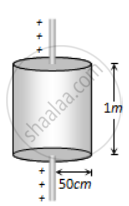Advertisements
Advertisements
प्रश्न
The electric force experienced by a charge of 1.0 × 10−6 C is 1.5 × 10−3 N. Find the magnitude of the electric field at the position of the charge.
उत्तर
Given:
Magnitude of the charges, q = 1.0 × 10−6 C
Electric force, F = 1.5 × 10−3 N
We know that F = qE
\[\Rightarrow E = \frac{F}{q} = \frac{1 . 5 \times {10}^{- 3}}{1 . 0 \times {10}^{- 6}} \]
\[ = 1 . 5 \times {10}^3\]N/C
APPEARS IN
संबंधित प्रश्न
A rod of length L has a total charge Q distributed uniformly along its length. It is bent in the shape of a semicircle. Find the magnitude of the electric field at the centre of curvature of the semicircle.
A positive charge q is placed in front of a conducting solid cube at a distance d from its centre. Find the electric field at the centre of the cube to the charges appearing on its surface.
A smple pendulum consists of a small sphere of mass m suspended by a thread of length l. The sphere carries a positive charge q. The pendulum is placed in a uniform electric field of strength E directed vertically downwards. Find the period of oscillation of the pendulum due to the electrostatic force acting on the sphere, neglecting the effect of the gravitational force.
Choose the correct option.
An electron is placed between two parallel plates connected to a battery. If the battery is switched on, the electron will
Choose the correct option.
Two point charges of +5 μC are so placed that they experience a force of 8.0 × 10-3N. They are then moved apart so that the force is now 2.0 × 10-3N. The distance between them is now
Two small conducting spheres of equal radius have charges +10 µC and -20 µC respectively and placed at a distance R from each other experience force F1· If they are brought in contact and separated to the same distance, they experience force F2. The ratio of F1 to F2 is ____________.
Electric charge is a property of ______.
Assertion: The positive charge particle is placed in front of a spherical uncharged conductor. The number of lines of forces terminating on the sphere will be more than those emerging from it.
Reason: The surface charge density at a point on the sphere nearest to the point charge will be negative and maximum in magnitude compared to other points on the sphere.
Electric charge is uniformly distributed along a long straight wire of radius 1 mm. The charge per cm length of the wire is Q coulomb. Another cylindrical surface of radius 50 cm and length 1 m symmetrically enclose the wire as shown in the figure. The total electric flux passing through the cylindrical surface is ______.

When a glass rod is rubbed with silk, it ______.
Total charge –Q is uniformly spread along length of a ring of radius R. A small test charge +q of mass m is kept at the centre of the ring and is given a gentle push along the axis of the ring.
- Show that the particle executes a simple harmonic oscillation.
- Obtain its time period.
A positive charge particle of 100 mg is thrown in opposite direction to a uniform electric field of strength 1 × 105 NC–1. If the charge on the particle is 40 μC and the initial velocity is 200 ms-1, how much distance it will travel before coming to the rest momentarily ______.
A straight infinitely long cylinder of radius R0 = 10 cm is uniformly charged with a surface charge density σ = + 10-12 C/m2. The cylinder serves as a source of electrons, with the velocity of the emitted electrons perpendicular to its surface. Electron velocity must be ______ × 105 m/s to ensure that electrons can move away, from the axis of the cylinder to a distance greater than r = 103 m.
Two particles A and B having the same mass have charges +q and +4q, respectively. When they are allowed to fall from rest through the same electric potential difference the ratio of their speeds vA to vB will become ______.
